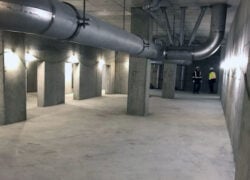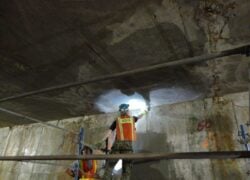Concrete is one of the most relied-upon materials in construction, used across infrastructure, commercial buildings, and residential projects due to its strength, durability, and versatility. But despite these benefits, concrete is inherently porous, which means it’s vulnerable to water intrusion. Over time, even minor moisture exposure can lead to cracking, corrosion, and structural failure. As the most widely used man-made material on the planet, concrete demands a smarter approach to protection, one that goes beyond traditional surface treatments. That’s where crystalline and cementitious waterproofing systems come in. The Challenge of Concrete’s Porosity At W. R. MEADOWS, we’ve been committed to…
Blog
Cementitious Waterproofing
Effective Waterproofing on Damp and Green Substrates
When dealing with concrete surfaces, one of the most persistent challenges is ensuring effective waterproofing, especially on damp or freshly poured (green) concrete. Many traditional waterproofing systems require a completely dry substrate, which can lead to delays and increased costs on the job site. However, cementitious waterproofing systems provide a solution that can be applied directly to damp and green concrete, ensuring both efficiency and durability. THE CHALLENGE OF DAMP AND GREEN CONCRETE Concrete surfaces often retain moisture for extended periods due to their curing process, and external conditions like rain or humidity can further prolong drying times. Traditional waterproofing…
Crystalline Waterproofing: The Science Behind It & Why It’s Important
Waterproofing is an essential aspect of construction that protects buildings from water damage and moisture-related issues. Concrete, which is a pivotal material in many structures, is porous and will absorb water, waterborne contaminants, and chemicals; all of which will call cause significant and expensive structural damage over time. Not to mention, can lead to mold growth and other health risks to those who work within said buildings/structures. There are multiple ways to waterproof, but Crystalline waterproofing has become a popular technique. Traditional waterproofing methods rely on a barrier system that prevents water from penetrating the surface. However, these systems can…
Epoxy/Urethane vs. Cementitious
Navigating Waterproofing Solutions for Water Tanks & Water Treatment Plants Waterproofing water tanks and treatment plants is a nuanced art, akin to crafting a custom-tailored suit. To the untrained eye, it might just seem like a choice between materials. However, engineers and architects know that the devil is in the details and with new materials and techniques coming to the forefront, it’s essential for builders and customers alike to stay abreast of the most effective solutions, especially when it comes to waterproofing. Water tanks and treatment plants, owing to their functionality, need the utmost care in terms of waterproofing and/or…
Cementitious Waterproofing in Elevator Pits: A Comprehensive Guide Series
Elevator pits are integral components of modern buildings, often hidden yet crucial for the operation of elevator systems. However, being located below ground level, these pits are inherently prone to water ingress, leading to potential corrosion, structural damage, and operational hazards. They are also quite challenging to access for restoration. In this context, cementitious waterproofing becomes a vital solution. Cementitious waterproofing, with its robust and reliable nature, stands as an ideal solution for safeguarding these subterranean spaces. This method employs a blend of cement and waterproofing materials to form a hard, durable barrier against moisture penetration. The concrete construction of…
How Do I Waterproof an Elevator Pit?
We get a lot of questions about how you waterproof an elevator pit, so our Canada technical representative Gary Tench, the ‘elevator pit whisperer,’ thought it was time to write an article about best practices. Here’s what Gary had to say: There are two methods for waterproofing an elevator pit: from the outside, or from the inside. Waterproofing from the outside, also known as positive-side waterproofing, is the best method for protecting the concrete, the steel, and also the interior space. When you waterproof your elevator pits during pre-construction, you get the maximum performance out of your waterproofing system when…

 USA
USA Canada
Canada Français
Français International
International




